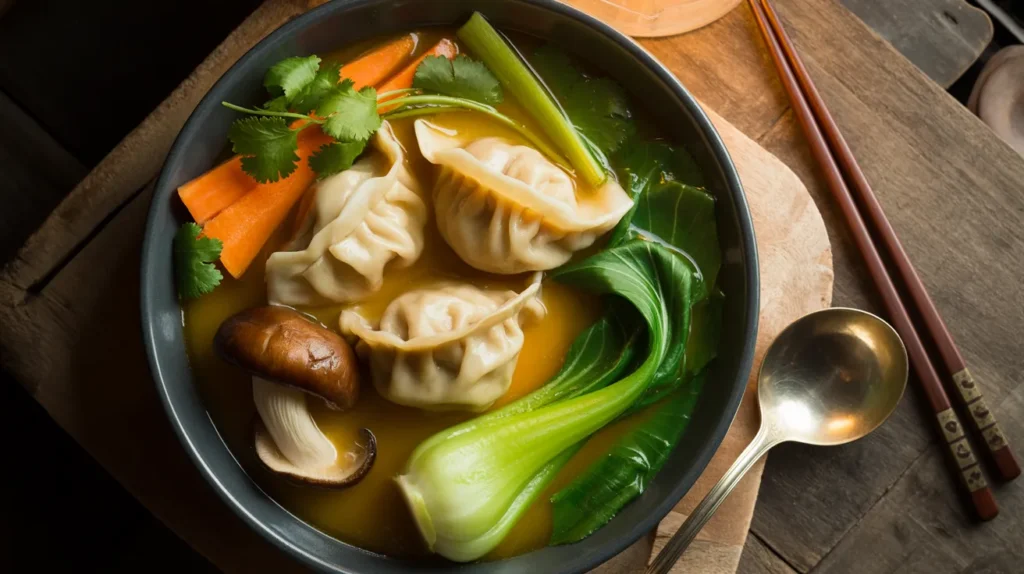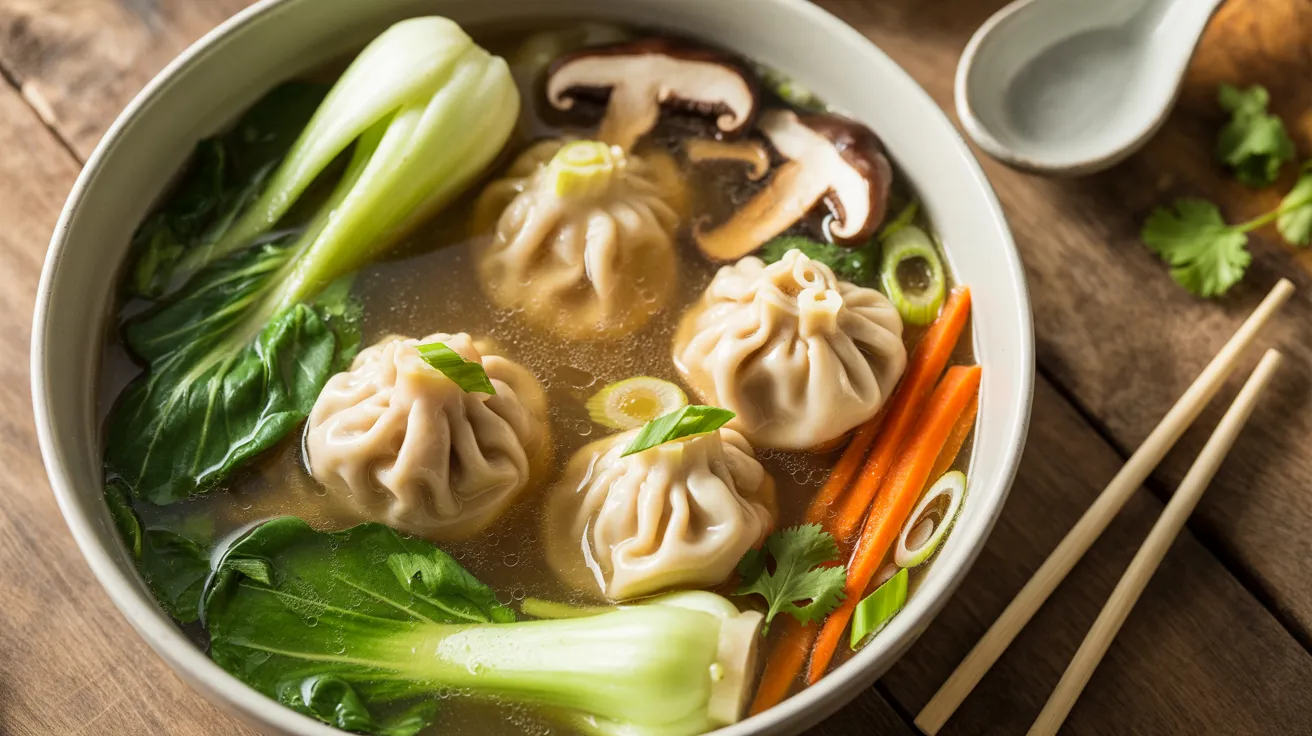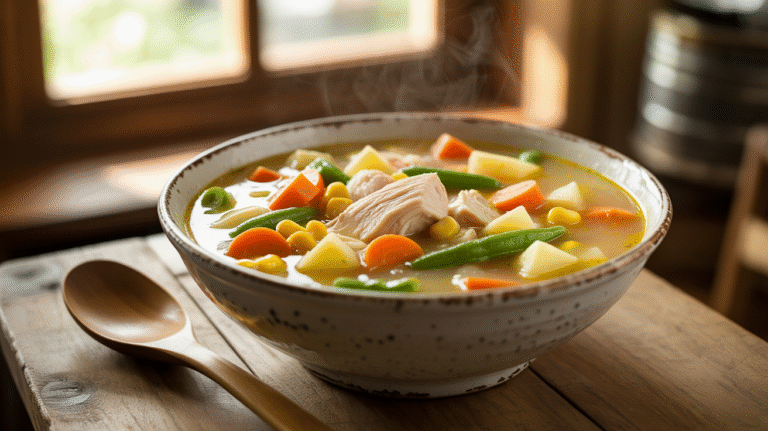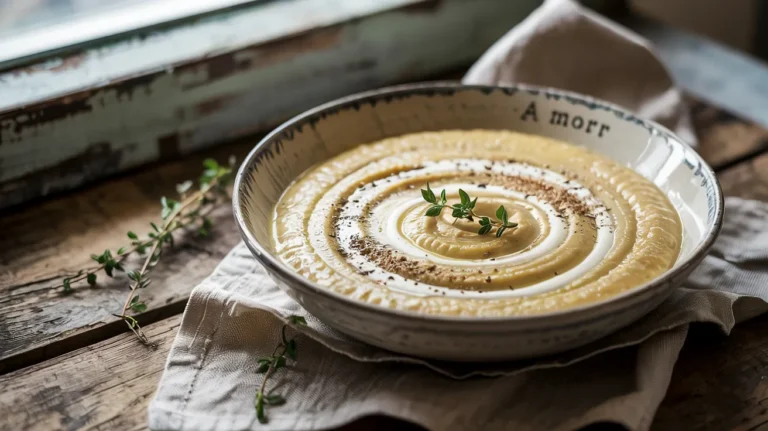This comforting potsticker soup with mushrooms and bok choy brings restaurant-quality flavors to your home kitchen with simple techniques any beginner can master. Featuring tender frozen dumplings, earthy shiitake mushrooms, and crisp bok choy in a savory broth, this potsticker soup with mushrooms and bok choy recipe creates a complete meal that’s both nourishing and delicious. Perfect for busy weeknights when you crave something warm and satisfying.
Recipe Info
SERVES: 4 | PREP: 20 MIN | COOK: 25 MIN | TOTAL: 45 MIN
Ingredients
Base & Broth
| Ingredient | Amount |
|---|---|
| Chicken or vegetable broth | 6 cups |
| Frozen potstickers (pork or chicken) | 16 pieces |
| Fresh ginger, minced | 2 tablespoons |
| Garlic cloves, minced | 4 cloves |
| Soy sauce | 3 tablespoons |
| Sesame oil | 1 tablespoon |
Vegetables
| Ingredient | Amount |
|---|---|
| Shiitake mushrooms, sliced | 8 ounces |
| Baby bok choy, chopped | 1 pound |
| Green onions, sliced | 4 stalks |
| Carrots, julienned | 2 medium |
Seasonings & Garnish
| Ingredient | Amount |
|---|---|
| Rice vinegar | 1 tablespoon |
| Chili garlic sauce | 1 teaspoon |
| Salt | To taste |
| White pepper | 1/4 teaspoon |
| Cilantro, chopped | 1/4 cup |
Detailed Step-by-Step Instructions for Beginners
Phase 1: Complete Prep Work (15 minutes)
1. Prepare your workspace: Clear a large cutting board and gather all ingredients. Fill a large bowl with cold water for cleaning vegetables. Having everything ready before you start cooking makes the process much smoother and prevents mistakes.
2. Prepare shiitake mushrooms: Remove mushrooms from packaging and examine each one. The stems of shiitake mushrooms are tough and chewy, so you need to remove them completely. Hold each mushroom cap-side down and twist off the stem where it meets the cap. Discard stems. Using a sharp knife, slice each cap into 1/4-inch thick pieces. Consistent sizing ensures even cooking – thicker pieces will be undercooked while thinner ones might become mushy.
3. Clean and prep bok choy properly: Bok choy grows in soil and can be quite sandy, so thorough cleaning is essential. Separate each bok choy head by cutting off the bottom inch where leaves connect. Pull apart individual leaves and place them in your bowl of cold water. Swish gently to remove dirt and grit. Lift leaves out (don’t pour water out as dirt settles at bottom). Pat completely dry with paper towels. The white stem portions need longer cooking than green leaves, so cut them separately. Chop white stems into 1-inch pieces and roughly chop green leafy parts. Keep them in separate piles on your cutting board.
4. Prepare aromatics: Fresh ginger can be tricky for beginners. Use a spoon edge to scrape off the thin brown skin – this works better than a peeler and wastes less ginger. Mince ginger very finely using a sharp knife, making pieces about 1/8-inch or smaller. For garlic, smash each clove with the flat side of your knife to loosen skin, then peel and mince finely. Both should release strong aromas when properly minced.
5. Prep remaining vegetables: For carrots, peel with vegetable peeler, then cut into matchstick-sized pieces (julienne). If you’re not comfortable with knife skills, you can use a vegetable peeler to create thin ribbons instead. For green onions, trim off root ends and any wilted green parts, then slice into thin rounds including both white and green portions.
6. Organize ingredients: Arrange all prepped ingredients in small bowls or plates near your stove. This technique, called “mise en place,” prevents scrambling during cooking and ensures you don’t forget any ingredients.
Phase 2: Build the Aromatic Broth Base (10 minutes)
7. Heat oil properly: Place a large, heavy-bottomed pot (at least 4-quart capacity) over medium heat. Add sesame oil and let it warm for about 30 seconds. You’ll know it’s ready when the oil moves freely and appears slightly shimmery on the surface. Don’t let it smoke – if it does, remove from heat briefly and lower temperature.
8. Cook aromatics without burning: Add minced ginger and garlic to the warm oil. You should hear a gentle sizzle – if there’s aggressive bubbling, your heat is too high. Stir constantly with a wooden spoon for 30-45 seconds. The mixture should become very fragrant and the garlic should turn slightly golden. This step builds the flavor foundation of your soup, but burned garlic tastes bitter and will ruin the entire dish.
9. Add mushrooms and develop flavor: Add all sliced shiitake mushrooms to the pot. Don’t worry if they seem crowded initially – they’ll shrink as they cook. Stir to coat with the oil and aromatics. Cook for 4-5 minutes, stirring occasionally. You’ll notice the mushrooms release moisture and start to brown around the edges. This browning process (called the Maillard reaction) creates deep, savory flavors essential to great soup.
10. Build the broth: Slowly pour in all 6 cups of broth. The liquid might bubble vigorously when it hits the hot pot – this is normal. Increase heat to medium-high and bring to a boil. You’ll see bubbles forming around the edges first, then across the entire surface. Once boiling, immediately reduce heat to medium-low to maintain a gentle simmer. A proper simmer shows small bubbles breaking the surface occasionally, not a rolling boil.
11. Season the base: Add soy sauce, rice vinegar, and chili garlic sauce to the simmering broth. Stir well to combine. Taste carefully with a clean spoon – the broth should be savory with a slight tang from the vinegar and gentle heat from the chili sauce. The flavor will seem strong now because vegetables and dumplings will dilute it slightly.
Phase 3: Cook Potstickers and Add Vegetables (12 minutes)
12. Add frozen potstickers correctly: Take potstickers directly from freezer – don’t thaw them first as thawed dumplings often fall apart during cooking. Gently lower each dumpling into the simmering broth using a spoon to prevent splashing. Don’t drop them from height. Stir very gently once to prevent sticking to pot bottom, but avoid aggressive stirring that might break delicate dumpling wrappers.
13. Cook dumplings to perfection: Maintain gentle simmer and cook potstickers for 8-10 minutes. Properly cooked dumplings will float to the surface and feel firm but not hard when gently pressed with a spoon. The wrapper should look translucent rather than doughy white. If you’re unsure, cut one open – the filling should be steaming hot throughout with no cold spots.
14. Add vegetables in proper sequence: Start with julienned carrots and bok choy stems (the white parts), as these need more cooking time. Add them to the pot and cook for 2-3 minutes until carrots start to soften slightly but still have some bite. They should be bright orange and beginning to bend when lifted with a spoon.
15. Add delicate greens: Now add the bok choy leaves (green parts). These cook very quickly – within 1-2 minutes they’ll wilt down significantly and turn bright green. Overcooked bok choy becomes slimy, so watch carefully. The leaves are done when wilted but still have some structure.
Phase 4: Final Seasoning and Perfect Presentation (8 minutes)
16. Taste and adjust seasoning: Remove pot from heat and let it cool for 1 minute so you can taste safely. Using a clean spoon each time, taste the broth and adjust seasonings. Add salt gradually – start with 1/4 teaspoon and taste again. Add more soy sauce for deeper umami flavor, or rice vinegar for brightness. White pepper adds gentle heat without overwhelming the other flavors.
17. Rest for optimal flavor: Let the potsticker soup with mushrooms and bok choy sit off heat for 2-3 minutes. This brief resting period allows all flavors to meld together and prevents you from burning your tongue on too-hot soup.
18. Serve with attention to presentation: Using a ladle, carefully portion soup into 4 bowls, ensuring each person gets exactly 4 potstickers and an equal amount of vegetables. The vegetables should look vibrant and the broth should be clear, not cloudy. Garnish each bowl with sliced green onions and fresh cilantro just before serving – this adds color, freshness, and aromatic appeal.
19. Final quality check: Each bowl should have a balanced appearance with colorful vegetables, plump dumplings, and aromatic broth. The soup should smell fragrant with ginger and sesame, and the first taste should be warm, savory, and satisfying.
Chef’s Notes for Perfect Potsticker Soup with Mushrooms and Bok Choy
Dumpling Selection: Quality matters significantly in this potsticker soup with mushrooms and bok choy. Look for frozen potstickers in the Asian section with plump, well-sealed edges. Pork and chive or chicken and vegetable varieties work best.
Mushroom Substitutions: If shiitakes aren’t available, baby bella or cremini mushrooms provide good flavor, though the taste will be milder in your potsticker soup with mushrooms and bok choy.
Broth Quality Impact: Use low-sodium broth so you control salt levels. High-quality broth makes an enormous difference in the final taste of this soup.
Timing Success: Prep all vegetables completely before starting to cook. This soup moves quickly once you begin, and having everything ready prevents overcooking.
Nutrition Per Serving
- Calories: 285
- Protein: 18g
- Carbohydrates: 32g
- Fat: 9g
- Fiber: 4g
- Sodium: 980mg
Creative Variations for Your Potsticker Soup
Spicy Korean-Style Potsticker Soup: Add 1 tablespoon gochujang and 1/2 cup kimchi during the last 5 minutes of cooking. The fermented flavors create incredible depth.
Creamy Coconut Version: Replace 2 cups broth with coconut milk and add 1 stalk lemongrass. This creates a rich, aromatic soup similar to our creamy Hungarian mushroom soup.
Hearty Vegetarian Potsticker Soup: Use vegetable broth and vegetable dumplings. Add cubed firm tofu and extra mushrooms for protein, creating a satisfying meal like our vegan white bean mushroom stew.
Ramen-Style Enhancement: Add cooked ramen noodles and top with a soft-boiled egg and sheets of nori for authentic Japanese flavors.
Storage & Reheating Your Potsticker Soup
Refrigerator Storage: Store cooled soup in airtight containers for up to 3 days. The potstickers actually absorb flavors and taste even better the next day.
Freezing Guidelines: This potsticker soup with mushrooms and bok choy freezes beautifully for up to 2 months. The dumplings maintain their texture surprisingly well when frozen in broth.
Proper Reheating: Warm gently on stovetop over medium-low heat, stirring occasionally. Microwave reheating can make potstickers rubbery and isn’t recommended.

Common Problems and Solutions
Problem: Cloudy or Murky Broth Solution: Maintain gentle simmer, never rolling boil. Aggressive boiling breaks down ingredients and creates cloudiness. Skim any foam during first 5 minutes.
Problem: Mushy, Overcooked Vegetables Solution: Add bok choy leaves last and cook only until wilted. They continue cooking in hot broth even after removing from heat.
Problem: Bland, Flavorless Soup Solution: Build flavors in layers. Sauté aromatics properly, season broth before adding vegetables, and taste frequently. Add more soy sauce rather than just salt.
Problem: Potstickers Falling Apart Solution: Never thaw frozen dumplings before cooking. Handle gently when stirring and avoid aggressive boiling that can break wrappers.
Problem: Overly Salty Taste Solution: Balance with rice vinegar or a pinch of sugar. If severely over-salted, dilute with additional unsalted broth.
Essential Equipment for Success
- Large heavy-bottomed pot (minimum 4-quart capacity)
- Sharp chef’s knife for efficient vegetable prep
- Large cutting board with good stability
- Wooden spoon for stirring without scratching pot
- Ladle for neat serving
- Small bowls for organizing prepped ingredients
Organized Shopping List
Asian/International Aisle
- Frozen potstickers (pork, chicken, or vegetable)
- Sesame oil
- Soy sauce (low-sodium preferred)
- Rice vinegar
- Chili garlic sauce
Fresh Produce Section
- Fresh ginger root
- Garlic bulbs
- Shiitake mushrooms (8 oz package)
- Baby bok choy (1 lb)
- Green onions/scallions
- Large carrots
- Fresh cilantro
Pantry/Canned Goods
- Chicken or vegetable broth (48 oz container)
- White pepper
- Salt
Five Success Secrets for Perfect Results
1. Master Your Knife Skills: Take time to prep vegetables uniformly. Consistent sizes ensure even cooking and professional appearance in your potsticker soup with mushrooms and bok choy.
2. Build Flavors Gradually: Each step adds flavor layers. Don’t rush the aromatics or skip browning the mushrooms – these steps create depth.
3. Control Your Heat: Gentle simmering preserves dumpling integrity and keeps broth clear. High heat causes problems for beginners.
4. Taste and Adjust: Season in stages and taste frequently. It’s easier to add flavor than remove it from your soup.
5. Timing Is Everything: Prep completely before cooking starts. This potsticker soup with mushrooms and bok choy comes together quickly once you begin, so organization prevents mistakes.




